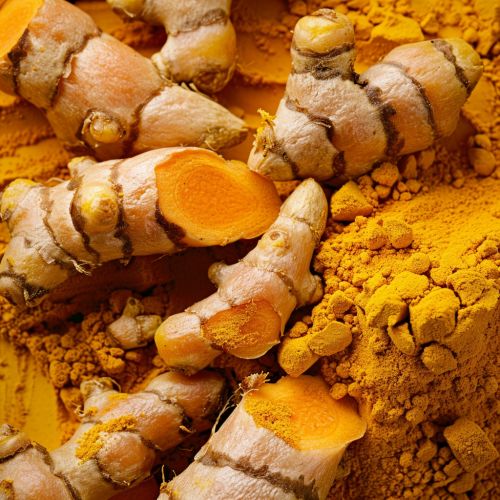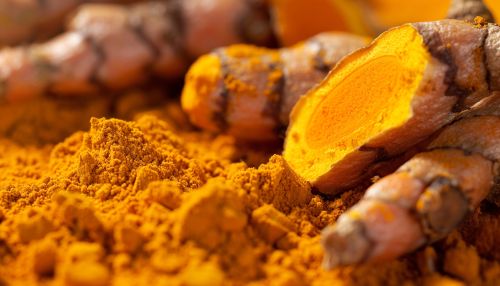Turmeric: Difference between revisions
(Created page with "== Introduction == <div class='only_on_desktop image-preview'><div class='image-preview-loader'></div></div><div class='only_on_mobile image-preview'><div class='image-preview-loader'></div></div> Turmeric, scientifically known as ''Curcuma longa'', is a flowering plant of the ginger family, Zingiberaceae. It is native to Southeast Asia and is widely cultivated in tropical regions. The rhizomes of the plant are used in cooking, traditional medicine, and as a dye. Turme...") |
No edit summary |
||
| Line 1: | Line 1: | ||
== Introduction == | == Introduction == | ||
[[Image:Detail-92075.jpg|thumb|center|Close-up of turmeric roots and powder.|class=only_on_mobile]] | |||
[[Image:Detail-92076.jpg|thumb|center|Close-up of turmeric roots and powder.|class=only_on_desktop]] | |||
Turmeric, scientifically known as ''Curcuma longa'', is a flowering plant of the ginger family, Zingiberaceae. It is native to Southeast Asia and is widely cultivated in tropical regions. The rhizomes of the plant are used in cooking, traditional medicine, and as a dye. Turmeric is renowned for its vibrant yellow color and its active compound, [[Curcumin|curcumin]], which has been extensively studied for its potential health benefits. | Turmeric, scientifically known as ''Curcuma longa'', is a flowering plant of the ginger family, Zingiberaceae. It is native to Southeast Asia and is widely cultivated in tropical regions. The rhizomes of the plant are used in cooking, traditional medicine, and as a dye. Turmeric is renowned for its vibrant yellow color and its active compound, [[Curcumin|curcumin]], which has been extensively studied for its potential health benefits. | ||
Latest revision as of 08:01, 18 June 2024
Introduction


Turmeric, scientifically known as Curcuma longa, is a flowering plant of the ginger family, Zingiberaceae. It is native to Southeast Asia and is widely cultivated in tropical regions. The rhizomes of the plant are used in cooking, traditional medicine, and as a dye. Turmeric is renowned for its vibrant yellow color and its active compound, curcumin, which has been extensively studied for its potential health benefits.
Botanical Characteristics
Turmeric is a perennial herbaceous plant that reaches up to 1 meter in height. The plant has large, oblong leaves that are arranged in a rosette pattern. The rhizomes, which are the underground stems, are the most valuable part of the plant. These rhizomes are harvested, boiled, dried, and ground into a fine powder.
Morphology
The turmeric plant has a distinctive morphology. The leaves are simple, alternate, and lanceolate with a smooth margin. The inflorescence is a spike with yellowish flowers that are hermaphroditic. The rhizomes are cylindrical, branched, and have a rough, segmented surface. The interior of the rhizome is bright orange-yellow, which is a characteristic feature of turmeric.
Chemical Composition
Turmeric contains a variety of bioactive compounds, the most notable of which is curcumin. Curcumin is a polyphenol that gives turmeric its yellow color and is responsible for many of its biological activities. Other important compounds include demethoxycurcumin, bisdemethoxycurcumin, and various volatile oils such as turmerone, atlantone, and zingiberene.
Curcuminoids
Curcuminoids are a group of compounds that include curcumin, demethoxycurcumin, and bisdemethoxycurcumin. These compounds are known for their antioxidant, anti-inflammatory, and anticancer properties. Curcumin, in particular, has been the subject of numerous studies investigating its potential therapeutic effects.
Volatile Oils
The volatile oils in turmeric contribute to its aroma and flavor. These oils include turmerone, atlantone, and zingiberene. Turmerone has been studied for its potential neuroprotective effects, while zingiberene contributes to the characteristic spicy flavor of turmeric.
Cultivation and Harvesting
Turmeric is cultivated in tropical and subtropical regions, with India being the largest producer. The plant requires a warm and humid climate with well-drained, fertile soil. It is typically grown from rhizome cuttings, which are planted in the soil and allowed to grow for 7-10 months before harvesting.
Soil and Climate Requirements
Turmeric thrives in loamy or sandy loam soils with good drainage and a pH range of 4.5 to 7.5. The plant requires a temperature range of 20-30°C and a high level of humidity. Adequate rainfall or irrigation is essential for optimal growth.
Harvesting and Processing
Harvesting of turmeric usually occurs 7-10 months after planting, when the leaves start to yellow and dry. The rhizomes are carefully dug out, cleaned, and boiled to remove the raw odor. They are then dried in the sun or in mechanical dryers before being polished and ground into powder.
Uses
Turmeric has a wide range of uses, spanning culinary, medicinal, and industrial applications.
Culinary Uses
Turmeric is a staple in many Asian cuisines, particularly in Indian, Thai, and Persian dishes. It is used as a spice to add flavor and color to curries, rice dishes, and soups. Turmeric is also a key ingredient in spice blends such as curry powder and garam masala.
Medicinal Uses
Turmeric has been used in traditional medicine systems such as Ayurveda and Traditional Chinese Medicine for centuries. It is believed to possess anti-inflammatory, antioxidant, and antimicrobial properties. Modern research has focused on curcumin's potential to treat conditions such as arthritis, cardiovascular diseases, and certain cancers.
Industrial Uses
In addition to its culinary and medicinal uses, turmeric is used as a natural dye in the textile industry. The yellow pigment, curcumin, is also used as a coloring agent in food products, cosmetics, and pharmaceuticals.
Pharmacological Properties
Turmeric and its active compounds have been extensively studied for their pharmacological properties. These include anti-inflammatory, antioxidant, antimicrobial, and anticancer activities.
Anti-inflammatory Properties
Curcumin has been shown to inhibit the activity of inflammatory enzymes such as cyclooxygenase-2 (COX-2) and lipoxygenase. It also modulates the expression of pro-inflammatory cytokines, making it a potential therapeutic agent for inflammatory diseases.
Antioxidant Properties
Curcumin and other curcuminoids exhibit strong antioxidant activity by scavenging free radicals and enhancing the activity of antioxidant enzymes. This property is crucial in preventing oxidative stress-related diseases.
Antimicrobial Properties
Turmeric has demonstrated antimicrobial activity against a range of bacteria, fungi, and viruses. This makes it a potential natural preservative and a therapeutic agent for infectious diseases.
Anticancer Properties
Curcumin has been studied for its potential anticancer effects. It can induce apoptosis (programmed cell death) in cancer cells, inhibit tumor growth, and prevent metastasis. These effects are mediated through various molecular pathways, including the inhibition of nuclear factor-kappa B (NF-κB) and the activation of p53.
Safety and Toxicity
Turmeric is generally considered safe when consumed in culinary amounts. However, high doses of curcumin supplements may cause gastrointestinal disturbances, such as nausea and diarrhea. It is important to consult with a healthcare provider before using turmeric or curcumin supplements, especially for individuals with gallbladder disease or those taking anticoagulant medications.
Research and Future Directions
Ongoing research is exploring the potential of turmeric and curcumin in various therapeutic areas. Clinical trials are investigating their efficacy in treating conditions such as Alzheimer's disease, diabetes, and inflammatory bowel disease. Advances in nanotechnology are also being used to enhance the bioavailability of curcumin, which is naturally poorly absorbed in the body.
